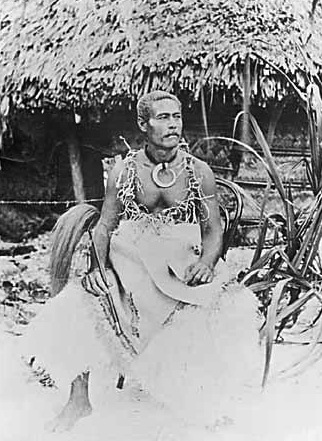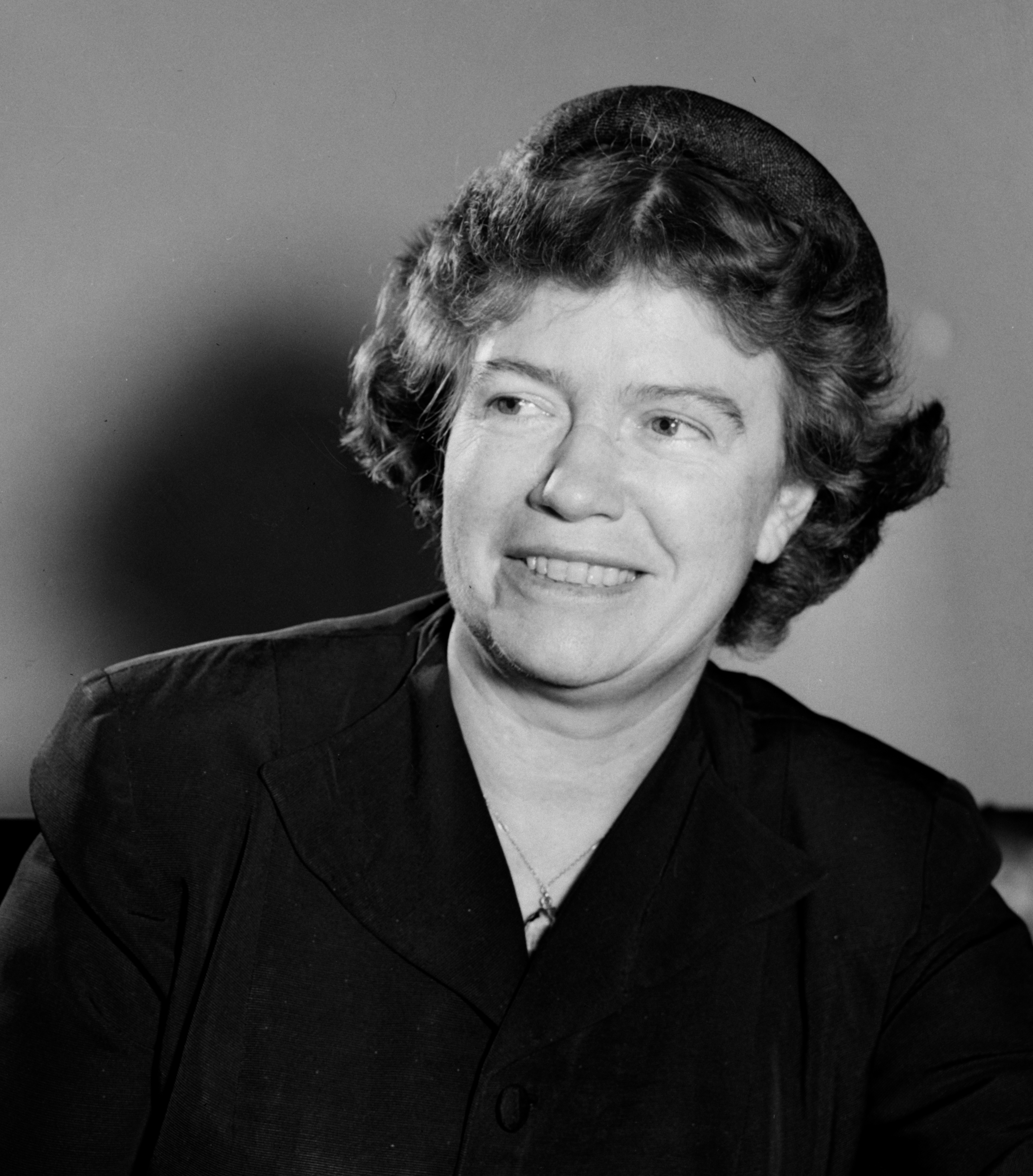|
Matelita
Tui Manu'a Matelita, born Margaret Young, and also known as Makelita, Matelika or Lika (31 December 1872 – 29 October 1895) was the Tui Manu'a (paramount chief or queen) of Manu'a, a group of islands in the eastern part of the Samoan Islands (present day American Samoa), from 1891 to 1895. During her tenure, she served largely a ceremonial role at her residence on Ta'ū where she received British writer Robert Louis Stevenson. Matelita never married, because she would not marry any of the eligible native chieftains and no other men were regarded as having the proper rank to marry her. She died of illness in 1895, although later reports claimed she died by a more violent means. She was buried in the Tui Manu'a Graves Monument. Life She was born on 31 December 1872. Her parents were Arthur Paʻu Young and Amipelia. Her father's heritage was half-Samoan and half-white; her grandfather was either a British or American surnamed Young and her grandmother was a Samoan woman of Fasi ... [...More Info...] [...Related Items...] OR: [Wikipedia] [Google] [Baidu] |
Tui Manu'a
The title Tui Manuʻa was the title of the ruler or paramount chief of the Manuʻa Islands in present-day American Samoa. The Tuʻi Manuʻa Confederacy, or Samoan Empire, are descriptions sometimes given to Samoan expansionism and projected hegemony in Oceania which began with the founding of the Tui Manu'a title. Traditional oral literature of Samoa and Manu'a talks of a widespread Polynesian network or confederacy (or "empire"). History The Tui Manu'a is the oldest title of Ancient Samoa. According to Samoan oral histories, the first Tui Manu'a was a direct descendant of the Samoan supreme god, Tagaloa. In Samoan lore, the islands of Manu'a (Ofu, Olosega, and Ta'u) are always the first lands to be created or drawn from the sea; consequently the Tui Manu'a is the first human ruler mentioned. This "senior" ranking of the Tui Manu'a title continues to be esteemed and acknowledged by Samoans despite the fact that the title itself has not been occupied since the American tak ... [...More Info...] [...Related Items...] OR: [Wikipedia] [Google] [Baidu] |
Tui Manuʻa Elisala
Tui Manua Elisara (died 2 July 1909) was the last Tui Manu'a titleholder in Manu'a, which is now part of the U.S. Territory of American Samoa. Elisala was the son of Tui Manua Alalamua whose genealogy descended from the Sa Tagaloa. Biography Tui Manu'a Elisara was born on the island of Ta'u as the second son of Tui Manu'a Alaalamua and Sofe, a daughter of Matiu of Ta'u island. Tui Manu'a Alalamua (of one of the female branches of the larger Anoalo clan called the Avaloa clan in the Tui Manu'a family) was the successor of Tui Manu'a Tauveve, also from the Falesoā clan. Shortly after the death of Tui Manu'a Alalamua a vigorous debate ensued among potential heirs. From the three main branches of the Tui Manu'a family, three candidates emerged from each clan as each endorsed by their own branches of the Tui Manu'a family and their political allies: Alaalamua's own son, Elisara (from the Avaloa clan) was named as an obvious contender although Elisara himself refused the title in l ... [...More Info...] [...Related Items...] OR: [Wikipedia] [Google] [Baidu] |
Chris Taliutafa Young
Taliutafa Christopher Leiesilika Young, also known as Christopher Taliutafa Young, Chris Young or Kilisi Young (20 December 1892 – 21 December 1967), was the last claimant to the traditional title Tui Manu'a (paramount chief or king) of Manu'a, a group of islands in the eastern part of the Samoan Islands (present day American Samoa). He was deposed from this title and exiled by American Governor Edward Stanley Kellogg because the idea of monarchy was incompatible with the Constitution of the United States. Biography His parents were Arthur Paʻu Young and of Amipelia or Amepelia. His father's heritage was half-Samoan and half-white; his grandfather was either a British or American surnamed Young and his grandmother was a Samoan woman of Fasito'o (located in the western Samoan Islands). On his mother's side, Young was a descendant of Tui Manu'a Taliutafa Tupolo, son of Tui Manu'a Moaatoa, of the ''anoalo'' class, the lineal descendants of the Tui Manu'a line. His elder sister ... [...More Info...] [...Related Items...] OR: [Wikipedia] [Google] [Baidu] |
Tui Manu'a Graves Monument
The Tui Manu'a Graves Monument is a funerary marker and grave site on the island Ta'u, the largest island of the Manu'a group in American Samoa. It is located northwest of the junction of Ta'u Village and Ta'u Island Roads on the west side of the island. It consists of a stone platform, about in height, that is roughly rectangular in shape with a projection at one end. Three graves are marked by square sections of smoothed stones, while a fourth is marked by a marble column. A possible fifth grave, unmarked, is in the projection. It is the burial site of several (four or five) tu'i, or kings, of Manu'a, including Tui Manu'a Matelita and Tui Manu'a Elisala, the Samoan leader whose signature granted the United States hegemony over the islands. The monument was listed on the National Register of Historic Places in 2015. See also *Tui Manu'a *National Register of Historic Places listings in American Samoa File:American Samoa Districts.png, 250px, American Samoa districts (c ... [...More Info...] [...Related Items...] OR: [Wikipedia] [Google] [Baidu] |
Kerosene Lamp
A kerosene lamp (also known as a paraffin lamp in some countries) is a type of lighting device that uses kerosene as a fuel. Kerosene lamps have a wick or mantle as light source, protected by a glass chimney or globe; lamps may be used on a table, or hand-held lanterns may be used for portable lighting. Like oil lamps, they are useful for lighting without electricity, such as in regions without rural electrification, in electrified areas during power outages, at campsites, and on boats. There are three types of kerosene lamp: flat-wick, central-draft (tubular round wick), and mantle lamp. Kerosene lanterns meant for portable use have a flat wick and are made in dead-flame, hot-blast, and cold-blast variants. Pressurized kerosene lamps use a gas mantle; these are known as Petromax, Tilley lamps, or Coleman lamps, among other manufacturers. They produce more light per unit of fuel than wick-type lamps, but are more complex and expensive in construction and more complex to oper ... [...More Info...] [...Related Items...] OR: [Wikipedia] [Google] [Baidu] |
19th-century Women Monarchs
The 19th century began on 1 January 1801 (represented by the Roman numerals MDCCCI), and ended on 31 December 1900 (MCM). It was the 9th century of the 2nd millennium. It was characterized by vast social upheaval. Slavery was abolished in much of Europe and the Americas. The First Industrial Revolution, though it began in the late 18th century, expanded beyond its British homeland for the first time during the 19th century, particularly remaking the economies and societies of the Low Countries, France, the Rhineland, Northern Italy, and the Northeastern United States. A few decades later, the Second Industrial Revolution led to ever more massive urbanization and much higher levels of productivity, profit, and prosperity, a pattern that continued into the 20th century. The Catholic Church, in response to the growing influence and power of modernism, secularism and materialism, formed the First Vatican Council in the late 19th century to deal with such problems and confirm ce ... [...More Info...] [...Related Items...] OR: [Wikipedia] [Google] [Baidu] |
1895 Deaths
Events January * January 5 – Dreyfus affair: French officer Alfred Dreyfus is stripped of his army rank and sentenced to life imprisonment on Devil's Island (off French Guiana) on what is much later admitted to be a false charge of treason. * January 6 – The Wilcox rebellion, an attempt led by Robert Wilcox to overthrow the Republic of Hawaii and restore the Kingdom of Hawaii, begins with royalist troops landing at Waikiki Beach in O'ahu and clashing with republican defenders. The rebellion ends after three days and the remaining 190 royalists are taken prisoners of war. * January 12 – Britain's National Trust for Places of Historic Interest or Natural Beauty is founded by Octavia Hill, Robert Hunter and Canon Hardwicke Rawnsley. * January 13 – First Italo-Ethiopian War: Battle of Coatit – Italian forces defeat the Ethiopians. * January 15 – A warehouse fire and dynamite explosion kills 57 people, including 13 firefighters in B ... [...More Info...] [...Related Items...] OR: [Wikipedia] [Google] [Baidu] |
1872 Births
Events January * January 12 – Yohannes IV is crowned Emperor of Ethiopian Empire, Ethiopia in Axum, the first ruler crowned in that city in over 500 years. *January 20 – The Cavite mutiny was an uprising of Filipino military personnel of Fort San Felipe (Cavite), Fort San Felipe, the Spanish arsenal in Cavite, Philippine Islands.Foreman, J., 1906, The set course for her patrol area off the northeastern coast of the main Japanese island Honshū. She arrived, New York: Charles Scribner's Sons February * February 2 – The government of the United Kingdom buys a number of forts on the Gold Coast (region), Gold Coast, from the Netherlands. * February 4 – A great solar flare, and associated geomagnetic storm, makes northern lights visible as far south as Cuba. * February 13 – Rex parade, Rex, the most famous parade on Mardi Gras, parades for the first time in New Orleans for Grand Duke Alexei Alexandrovich of Russia. * February 17 – Filipino peo ... [...More Info...] [...Related Items...] OR: [Wikipedia] [Google] [Baidu] |
University Of Hawaii Press
A university () is an institution of tertiary education and research which awards academic degrees in several academic disciplines. ''University'' is derived from the Latin phrase , which roughly means "community of teachers and scholars". Universities typically offer both undergraduate and postgraduate programs. The first universities in Europe were established by Catholic monks. The University of Bologna (), Italy, which was founded in 1088, is the first university in the sense of: *being a high degree-awarding institute. *using the word (which was coined at its foundation). *having independence from the ecclesiastic schools and issuing secular as well as non-secular degrees (with teaching conducted by both clergy and non-clergy): grammar, rhetoric, logic, theology, canon law and notarial law.Hunt Janin: "The university in medieval life, 1179–1499", McFarland, 2008, , p. 55f.de Ridder-Symoens, Hilde''A History of the University in Europe: Volume 1, Universities in th ... [...More Info...] [...Related Items...] OR: [Wikipedia] [Google] [Baidu] |
Margaret Mead
Margaret Mead (December 16, 1901 – November 15, 1978) was an American cultural anthropologist, author and speaker, who appeared frequently in the mass media during the 1960s and the 1970s. She earned her bachelor's degree at Barnard College of Columbia University and her M.A. and Ph.D. degrees from Columbia. Mead served as president of the American Association for the Advancement of Science in 1975. Mead was a communicator of anthropology in modern American and Western culture and was often controversial as an academic. Her reports detailing the attitudes towards sex in South Pacific and Southeast Asian traditional cultures influenced the 1960s sexual revolution. She was a proponent of broadening sexual conventions within the context of Western cultural traditions. Early life and education Margaret Mead, the first of five children, was born in Philadelphia but raised in nearby Doylestown, Pennsylvania. Her father, Edward Sherwood Mead, was a professor of finance at th ... [...More Info...] [...Related Items...] OR: [Wikipedia] [Google] [Baidu] |







